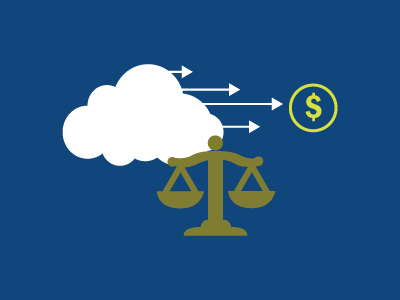When you choose legal software, you are choosing a product that makes your job easier. From hours tracking to practice management to your professional services accounting software, everything needs to work together to help your firm move forward. However, in addition to the software, there is another discussion—where it’s stored. The rise of the cloud in the past two decades has given law firms another option for the way they run their information technology strategy and has provided firms a wide range of benefits.
Following our last blog on the idea of scalability—pay for what you need when you need it, we would today like to turn our attention to a different form of flexibility, pricing flexibility.
The Traditional On-Premises Landscape: Massive Up-Front Costs, Ongoing Challenges
Barring a move from desktop software (for solo firms), you likely understand the process of moving to something new. Buy licenses and buy an appropriate server to host the software; pay to implement the software, convert data, train the employees, and ultimately get up and running.
Initial Costs of On-Premises Applications
Say you buy 100 licenses for an on-premises practice management software. Before you can even use these licenses, you need to set up the infrastructure:
- Server hardware
- Server Software
- Backup hardware and software
- Ancillary Server equipment
All of this is just to get up and running—at your own office. If you want a somewhat mobile solution from your on-premises application, you have to pay to implement remote desktop services.
These capital expenditures, large up-front investments that are depreciated over the life of the product, are unavoidable in the on-premises world. While they do present tax implications (spread the overall cost of the equipment over years through depreciation), you still need to foot the bill up front. This often means companies need to have money in place to make the investment.
The Ongoing Challenge of Keeping Up
While the on-premises implementation and hardware fees represent a healthy portion of any software, how long will it provide you reliable service? Updates happen, software needs change, and even if you have ample server size, you may not have the right server specs to handle future system requirements.
After a few years, you hit a breaking point—you can’t update the software because your hardware can’t support it. At this time, you have two options: Go through the hardware upgrade process—again—or continue to run software that isn’t receiving updates at a risk to your security and compliance.
Servers have a useful life of about five years, and continued use after that is risky.
Growth?
When you look to purchase on-premises, you likely buy for a predictable period of growth (i.e. buying more than you need now). This not only adds to the up-front costs (paying more than you need), it doesn’t factor in the concept of growth you can’t predict. A study shared on the Rainmaker Institute found that high-growth firms see 34% median annual growth rate. Scalability is nonexistent in the on-premises world, as we discussed in our last blog.
How the Cloud Has Made Acquisition Easier
Alternatively, law firms have the option to host their applications in the cloud. Offering a much more business-friendly pricing model, cloud hosting removes the hardware acquisition part of the equation, replacing it with a consistent monthly fee. After a relatively low-cost setup, migration, and data conversion process, you are good to go—your hosting provider handles the rest.
Operational Expenditures Make Accounting Simpler
When you move to the cloud, you completely remove the cost of hardware from the equation, replacing the initial costs with a transparent and predictable monthly fee. Rather than “investing” in something that is going to be useless five years from now, you can ‘set it and forget it,’ knowing that you won’t need to worry about things like expected useful life of hardware.
In next week’s blog, we will explore how accounting standards have changed regarding setup costs in the cloud and why these changes have made it even more affordable to use cloud hosting.
Easier to Operate
Not only do you free yourself from the trials and tribulations of buying hardware every five years, you free your IT team from another challenge—updating or upgrading software. With a cloud hosting subscription, when it’s time to update, the update just happens. Your vendor notifies you in advance of the time that maintenance may occur and you log in the next day to the improved software.
Never Worry about Hardware
When you work with a cloud provider, not only are software updates included in your fees, so are hardware upgrades. When you move to the cloud, you will always be on hardware that is always up-to-date and can handle your needs.
Flywire Technology: Legal Software Cloud Hosting on Your Terms
Flywire eliminates the high costs of hardware acquisition. Our subscription-based models allows you to simply pay as you go while we take care of the hardware needs. This ease of set up and management lets you remain focused on your profits rather than worrying about your costs. Get to know more about this and other benefits of hosting your legal software in the cloud here, learn more about our long history of providing cloud hosting for law firms, and contact us for a free consultation.

